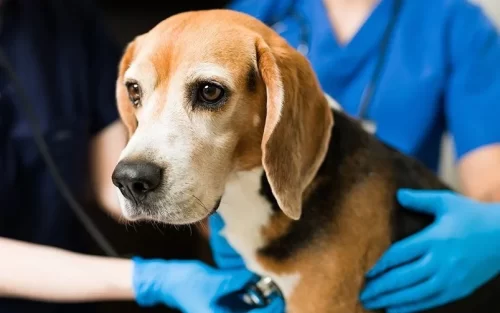How much should I feed my dog? It’s a question all of us grapple with. Feeding your dog the right amount of food is essential for their overall health and well-being. It can be challenging to determine the appropriate amount of food to feed your dog, as it can vary depending on their age, weight, breed, and activity level. In this guide, we’ll explore the factors that can influence how much to feed your dog. We’ll also provide some guidelines for determining the appropriate portion size.
Factors That Affect How Much to Feed Your Dog:
- Age: The appropriate amount of food for your dog can depend on their age. Puppies, for example, require more calories per pound of body weight. This is due to their high energy needs for growth and development. Senior dogs, on the other hand, may require fewer calories due to their slower metabolism and decreased activity level.
- Weight: The amount of food your dog needs can also depend on their weight. Dogs that are overweight or obese may need to consume fewer calories to achieve a healthy weight. Underweight dogs may need to consume more calories to reach a healthy weight.
- Breed: The breed of your dog can also play a role in how much food they need. Large breeds, such as Great Danes or St. Bernards, may require more calories than smaller breeds, such as Chihuahuas or Yorkies.
- Activity Level: The amount of food your dog needs can also depend on their activity level. Dogs that are highly active, such as working or sporting breeds, may require more calories than dogs that are less active, such as couch potatoes.
- Health Conditions: Certain health conditions, such as thyroid problems, diabetes, or heart disease, may require a special diet or feeding schedule for your dog. If your dog has been diagnosed with a health condition, talk to your veterinarian about the appropriate diet and feeding schedule for their needs.
So, how much should I feed my dog?
What is the ideal weight for my dog’s breed and size?
The ideal weight for a dog can vary depending on their breed and size. Generally, larger breeds will weigh more than smaller breeds. To determine your dog’s ideal weight, you can consult breed-specific weight charts or talk to your veterinarian. It’s important to maintain a healthy weight for your dog, as being overweight can lead to health problems like joint pain, heart disease, and diabetes. On the other hand, being underweight can also indicate health problems or nutritional deficiencies. Regular weigh-ins and body condition scoring can help you monitor your dog’s weight and adjust their diet as needed.
What is the caloric content of the food I’m feeding my dog?
The caloric content of dog food can vary widely depending on the brand, type, and recipe. To determine how many calories your dog needs, you can use a formula based on their weight and activity level or consult with your veterinarian. Once you know how many calories your dog needs per day, you can calculate the appropriate portion size based on the caloric content of the food you’re feeding them. Be sure to read the nutritional information on the dog food packaging carefully, and adjust portion sizes as needed based on your dog’s weight and activity level.
Does my dog have any health conditions that require a special diet or feeding schedule?
Certain health conditions, such as allergies, digestive issues, and kidney disease, may require a special diet or feeding schedule for your dog. If your dog has been diagnosed with a health condition, talk to your veterinarian about the appropriate diet and feeding schedule for their needs. They may recommend a prescription diet or specific nutritional supplements to support your dog’s health.
How active is my dog and what is their lifestyle like?
The amount of food your dog needs can depend on their activity level and lifestyle. Dogs who are very active, such as working or sporting breeds, may need more calories than dogs who have a more sedentary lifestyle. Likewise, dogs who are pregnant or nursing may need more calories to support their increased nutritional needs. If your dog is getting too little exercise or too much exercise, you may need to adjust their food intake accordingly to maintain a healthy weight.
What is the recommended portion size for my dog’s age, weight, and activity level?
The recommended portion size for your dog can depend on several factors. This can include their age, weight, and activity level. In general, adult dogs should be fed one or two meals per day, with portion sizes based on their weight and activity level. Puppies may need to be fed more frequently, with smaller portion sizes. Consult with your veterinarian to determine the appropriate portion sizes and feeding schedule for your dog’s specific needs.
How often should I feed my dog, and at what times of day?
The frequency and timing of your dog’s meals can depend on their age, breed, and activity level. In general, adult dogs should be fed one or two meals per day. Puppies and senior dogs potentially need more frequent meals. It’s important to establish a regular feeding schedule and stick to it, as this can help prevent digestive problems and establish a routine for your dog. Talk to your veterinarian about the appropriate feeding schedule for your dog’s needs.
Should I feed my dog a commercial dog food or a homemade diet?
Commercial dog food is designed to meet the nutritional needs of dogs and can be a convenient and cost-effective option. However, some owners prefer to feed their dogs a homemade diet. This gives them more control over the ingredients and quality of the food. If you’re considering feeding your dog a homemade diet, it’s important to work with a veterinary nutritionist. This will ensure that the diet is balanced and meets your dog’s nutritional needs. Homemade diets that are not properly balanced can lead to health problems and nutritional deficiencies. Additionally, it’s important to be aware of potential food safety issues when preparing and storing homemade dog food.
How many treats should I give my dog each day, and should they be factored into their daily caloric intake?
Treats can be a great way to reward your dog, but it’s important not to overdo it. Treats should make up no more than 10% of your dog’s daily caloric intake. If your dog is overweight or obese, it’s a good idea to cut back on treats or choose low-calorie options. Be sure to read the labels on dog treats carefully, as some can be high in calories and sugar. You can also use healthy human foods, such as carrots or green beans, as treats for your dog.
What is the appropriate feeding schedule for puppies, adult dogs, and senior dogs?
The appropriate feeding schedule for dogs can vary depending on their age and developmental stage. Puppies may need to be fed more frequently than adult dogs, with smaller portion sizes. Senior dogs may have special dietary needs, such as reduced calories or softer food, to accommodate changes in their teeth or digestion. Consult with your veterinarian to determine the appropriate feeding schedule and portion sizes for your dog’s age and developmental stage.
What are the signs that my dog may be overfed or underfed?
It’s important to monitor your dog’s weight and overall health to ensure that they are getting the appropriate amount of food. Signs that your dog may be overfed include excessive weight gain, lethargy, and decreased activity levels. Signs that your dog may be underfed include weight loss, lethargy, and lack of energy. Be sure to consult with your veterinarian if you have concerns about your dog’s weight or nutritional needs. They can help you determine the appropriate diet and feeding schedule for your dog’s needs.
Determining the Appropriate Portion Size
Once you have considered the factors that can influence how much to feed your dog, you can begin to determine the appropriate portion size. Here are some guidelines to help you determine the appropriate amount of food to feed your dog:
- Consult with your veterinarian: Your veterinarian can help you determine the appropriate amount of food to feed your dog based on their individual needs. They can take into account your dog’s age, weight, activity level, and any health conditions to provide you with a personalized feeding plan.
- Use a feeding calculator: Online feeding calculators can help you determine the appropriate amount of food to feed your dog. They are often based on their weight and activity level. However, these calculators are not always accurate and should be used as a rough guide only.
- Follow the feeding guidelines on the dog food packaging: Most commercial dog food brands provide feeding guidelines on their packaging. These guidelines can give you an idea of the appropriate portion size based on your dog’s weight and activity level. However, it’s important to keep in mind that these guidelines may not be suitable for all dogs. You may need to adjust the portion size based on your dog’s individual needs.
- Monitor your dog’s weight and adjust the portion size as needed: It’s important to monitor your dog’s weight regularly and adjust the portion size as needed to maintain a healthy weight. If your dog is gaining weight, you may need to reduce the portion size or switch to a lower-calorie dog food. If your dog is losing weight, you may need to increase the portion size or switch to a higher-calorie dog food.
Conclusion
Determining the appropriate amount of food to feed your dog can be challenging, but it’s important for their overall health and well-being. Consider factors such as your dog’s age, weight, breed, and activity level when determining the appropriate portion size. Consult with your veterinarian, use feeding calculators, and monitor your dog’s weight regularly to ensure that they are getting the appropriate amount of food. By following these guidelines, you can help ensure that your dog stays healthy and happy. Remember that feeding your dog is an important part of being a responsible pet owner, and the right amount and quality of food can contribute to a long and happy life for your furry friend.



